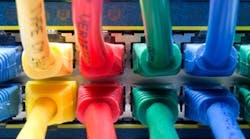Jim Montague is the Executive Editor of Control. Jim has spent the last 13 years as an editor and brings a wealth of automation and controls knowledge to the position.
"There are different levels of redundancy in managed Ethernet switches," says Mark Devonshire, product manager for Rockwell Automation's Stratix Ethernet switches. "But the main question is: Is there a redundant path for my data? This usually means employing Rapid Spanning Tree Protocol (RSTP), which uses a ring-type architecture to provide that redundant path in less than one second after a network break is detected. However, this isn't fast enough for a lot of machine control and device-level I/O. These might need a device-level ring (DLR) with one fault-tolerant ring network that uses a protocol supervisor and has 1 ms recovery time. This is helpful because we're seeing a lot more requirements for faster, redundant Ethernet infrastructures inside plants."
Charlie Norz, product manager for I/O systems at Wago, agrees that more users are concerned about redundancy. "So about a year ago, we introduced managed Ethernet switches with ring topology," he says. "They can use our Jet Ring protocol with 300 ms recovery or our Xpress ring protocol with 50 ms recovery, and they can set it up with a check box on the switch's web-based management display."
The most common redundant topology for Ethernet switches is a ring, but open protocols like RSTP aren't as fast on it as proprietary protocols. The tradeoff is that proprietary protocols aren't interoperable, so efforts are underway to secure the best of both. "The newest technology for our Ethernet switches and networks is our 2- to 3-year-old Turbo Chain, which enables interoperability with RSTP and other networks, but still has fast recovery where needed," explains Jim Toepper, product manager for Moxa's Industrial Ethernet Infrastructure Group. "Turbo Chain allows plant-floor sections of the network to run on our 7- to 10-year-old Turbo Ring with down to 12 ms recovery, but it lets control room and enterprise sections use RSTP where 1–5 s recovery is acceptable."
Likewise, Phoenix Contact is examining interoperability, and also exploring how open and proprietary mechanisms can work together, reports Ken Austin, Phoenix Contact product specialist for Ethernet. "Our proprietary Fast Ring detector allows interoperability," he says. "So Fast Ring ports on an Ethernet switch can work with a high-speed ring, while its spare ports can connect with RSTP components. We also tweaked Fast Ring to work with IGMP snooping."
Mike Miclot, marketing vice president of Belden's Industrial Solutions division, adds, "Users are finding that network outages can be very costly, so they're looking at likely causes, and backing up power supplies, reducing mean time to recovery (MTTR) with spare components and device configurations, addressing plant environment issues, and adopting more managed Ethernet switches. And, just as Ethernet switches became deterministic, we're seeing their switchover times shrink on the way to instant or bumpless switchover with no data loss. In fact, our Hirschmann division will soon launch a managed Ethernet switch with bumpless switchover in ring or tree topologies."
For some developers, the best way to make an Ethernet network redundant is to get rid of the switch itself. "Users of industrial Ethernet protocols should realize that any switch-, router- or hub-based architecture will have poor performance, high jitter and high cost," argues Joey Stubbs, North American representative of the EtherCAT Techology Group. "They almost always must be sourced from one vendor, which can result in users being held captive. However, EtherCAT was designed to eliminate the need for switches, spanning-tree topologies and active infrastructure components in industrial Ethernet systems. Any span of an EtherCAT network or the entire network can have added availability or redundant media by connecting the end of the segment to a second Ethernet port on the controller. So any cable fault, removing any device or power loss, causes the backup frame to activate in the segment connected to the second port with a 15 µs switchover time, which means it's possible to lose only one frame upon a fault. The slave devices don't even know they are part of a redundant system, and there are no external devices to configure."





